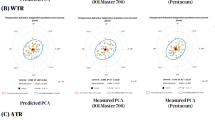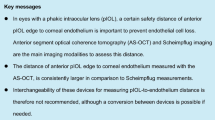Abstract
Purpose
This study evaluated the relationship between refractive outcomes and postoperative anterior chamber depth (ACD, measured from corneal epithelium to lens) measured by swept-source optical coherence tomography (SS-OCT), optical low-coherence reflectometry (OLCR), and Scheimpflug devices under the undilated pupil.
Methods
Patients undergoing cataract phacoemulsification with intraocular lens (IOL) implantation in a hospital setting were enrolled. Postoperative ACD (postACD) was performed with an SS-OCT device, an OLCR device, and a Scheimpflug device at least 1 month after cataract surgery. After adjusting the mean predicted error to 0, differences in refractive outcomes were calculated with the Olsen formula using actual postACD measured from 3 devices and predicted value.
Results
Overall, this comparative case study included 69 eyes of 69 patients, and postACD measurements were successfully taken using all 3 devices. The postACD measured with the SS-OCT, OLCR, and Scheimpflug devices was 4.59 ± 0.30, 4.50 ± 0.30, and 4.54 ± 0.32 mm, respectively. Statistically significant differences in postACD were found among 3 devices (P < 0.001), with intraclass correlation coefficients (ICCs) and Bland-Altman showing good agreement. No significant difference in median absolute error was found with the Olsen formula using actual postACD obtained with 3 devices. Percentage prediction errors were within ± 0.50 D in 65% (OLCR), 70% (Scheimpflug), and 67% (SS-OCT) calculated by actual postACD versus 64% by predicted value.
Conclusion
Substantial agreement was found in postACD measurements obtained from the SS-OCT, OLCR, and Scheimpflug devices, with a trend toward comparable refractive outcomes in the Olsen formula. Meanwhile, postACD measurements may be potentially superior for the additional enhancement of refractive outcomes.


Similar content being viewed by others
Data availability
The data used to support the findings of this study are available from the corresponding author upon request.
References
Olsen T (1992) Sources of error in intraocular lens power calculation. J Cataract Refract Surg 18:125–129. https://doi.org/10.1016/s0886-3350(13)80917-0
Norrby S (2008) Sources of error in intraocular lens power calculation. J Cataract Refract Surg 34:368–376. https://doi.org/10.1016/j.jcrs.2007.10.031
Savini G, Hoffer KJ, Carbonelli M (2013) Anterior chamber and aqueous depth measurement in pseudophakic eyes: agreement between ultrasound biometry and scheimpflug imaging. J Refract Surg 29:121–125. https://doi.org/10.3928/1081597X-20130117-07
Olsen T (2007) Calculation of intraocular lens power: a review. Acta Ophthalmol Scand 85:472–485. https://doi.org/10.1111/j.1600-0420.2007.00879.x
Olsen T (2006) Prediction of the effective postoperative (intraocular lens) anterior chamber depth. J Cataract Refract Surg 32:419–424. https://doi.org/10.1016/j.jcrs.2005.12.139
Shajari M, Cremonese C, Petermann K et al (2017) Comparison of axial length, corneal curvature, and anterior chamber depth measurements of 2 recently introduced devices to a known biometer. Am J Ophthalmol 178:58–64. https://doi.org/10.1016/j.ajo.2017.02.027
Cheng H, Li J, Cheng B, Wu M (2020) Refractive predictability using two optical biometers and refraction types for intraocular lens power calculation in cataract surgery. Int Ophthalmol 40:1849–1856. https://doi.org/10.1007/s10792-020-01355-y
Hoffer KJ, Savini G (2015) Anterior chamber depth studies. J Cataract Refract Surg 41:1898–1904. https://doi.org/10.1016/j.jcrs.2015.10.010
Nemeth G, Vajas A, Kolozsvari B et al (2006) Anterior chamber depth measurements in phakic and pseudophakic eyes: pentacam versus ultrasound device. J Cataract Refract Surg 32:1331–1335. https://doi.org/10.1016/j.jcrs.2006.02.057
Hamoudi H, Correll Christensen U, La Cour M (2018) Agreement of phakic and pseudophakic anterior chamber depth measurements in IOLMaster and Pentacam. Acta Ophthalmol 96:e403. https://doi.org/10.1111/aos.13599
Kane JX, Chang DF (2021) Intraocular lens power formulas, biometry, and intraoperative aberrometry. Ophthalmol 128:e94–e114. https://doi.org/10.1016/j.ophtha.2020.08.010
Takabatake R, Takahashi M (2021) Preoperative factors affecting visual acuity following the implantation of diffractive multifocal intraocular lenses. J Refract Surg 37:674–679. https://doi.org/10.3928/1081597X-20210712-01
Bu Q, Hu D, Zhu H et al (2023) Swept-source optical coherence tomography and ultrasound biomicroscopy study of anterior segment parameters in primary angle-closure glaucoma. Graefes Arch Clin Exp Ophthalmol 261:1651–1658. https://doi.org/10.1007/s00417-022-05970-6
Olsen T, Hoffmann P (2014) C constant: new concept for ray tracing–assisted intraocular lens power calculation. J Cataract Refract Surg 40:764–773. https://doi.org/10.1016/j.jcrs.2013.10.037
Hoffer KJ, Savini G (2021) Update on intraocular lens power calculation study protocols. Ophthalmol 128:e115–e120. https://doi.org/10.1016/j.ophtha.2020.07.005
Qin Y, Liu L, Mao Y et al (2023) Accuracy of intraocular lens power calculation based on total Keratometry in patients with flat and steep corneas. Am J Ophthalmol 247:103–110. https://doi.org/10.1016/j.ajo.2022.11.011
Luft N, Hirnschall N, Farrokhi S, Findl O (2015) Comparability of anterior chamber depth measurements with partial coherence interferometry and optical low-coherence reflectometry in pseudophakic eyes. J Cataract Refract Surg 41:1678–1684. https://doi.org/10.1016/j.jcrs.2015.08.013
Norrby S (2004) Using the lens haptic plane concept and thick-lens ray tracing to calculate intraocular lens power. J Cataract Refract Surg 30:1000–1005. https://doi.org/10.1016/j.jcrs.2003.09.055
Jin H, Rabsilber T, Ehmer A et al (2009) Comparison of ray-tracing method and thin-lens formula in intraocular lens power calculations. J Cataract Refract Surg 35:650–662. https://doi.org/10.1016/j.jcrs.2008.12.015
Olsen T (2011) Use of fellow eye data in the calculation of intraocular lens power for the second eye. Ophthalmol 118:1710–1715. https://doi.org/10.1016/j.ophtha
Findl O, Drexler W, Menapace R et al (1998) High precision biometry of pseudophakic eyes using partial coherence interferometry. J Cataract Refract Surg 24:1087–1093. https://doi.org/10.1016/s0886-3350(98)80102-8
Kriechbaum K, Findl O, Kiss B et al (2003) Comparison of anterior chamber depth measurement methods in phakic and pseudophakic eyes. J Cataract Refract Surg 29:89–94. https://doi.org/10.1016/s0886-3350(02)01822-9
Kriechbaum K, Leydolt C, Findl O et al (2006) Comparison of partial coherence interferometers: acmaster versus laboratory prototype. J Refract Surg 22:811–816. https://doi.org/10.3928/1081-597X-20061001-12
Su P-F, Lo AY, Hu C-Y, Chang S-W (2008) Anterior chamber depth measurement in phakic and pseudophakic eyes. Optom Vis Sci 85:1193–1200. https://doi.org/10.1097/OPX.0b013e31818e8ceb
Zhang Q, Jin W, Wang Q (2010) Repeatability, reproducibility, and agreement of central anterior chamber depth measurements in pseudophakic and phakic eyes: optical coherence tomography versus ultrasound biomicroscopy. J Cataract Refract Surg 36:941–946. https://doi.org/10.1016/j.jcrs.2009.12.038
Savini G, Olsen T, Carbonara C et al (2010) Anterior chamber depth measurement in pseudophakic eyes: a comparison of pentacam and ultrasound. J Refract Surg 26:341–347. https://doi.org/10.3928/1081597X-20090617-02
Rodriguez-Raton A, Jimenez-Alvarez M, Arteche-Limousin L et al (2015) Effect of pupil dilation on biometry measurements with partial coherence interferometry and its effect on IOL power formula calculation. Eur J Ophthalmol 25:309–314. https://doi.org/10.5301/ejo.5000568
Hildebrandt AL, Auffarth GU, Holzer MP (2011) Precision of a new device for biometric measurements in pseudophakic eyes. Ophthalmologe 108:739–744. https://doi.org/10.1007/s00347-011-2373-2
Xu Y, Liu L, Li J et al (2021) Refractive outcomes and anterior chamber depth after cataract surgery in eyes with and without previous pars plana vitrectomy. Curr Eye Res 46:1333–1340. https://doi.org/10.1080/02713683.2021.1887271
Acknowledgements
The authors thank statistician Ling Jin from Zhongshan Ophthalmic Center, Sun Yat-sen University, for statistical consultation.
Funding
This work was supported by the National Natural Science Foundation of China (No. 81770909 and No. 81970783).
Author information
Authors and Affiliations
Contributions
All authors contributed to the study conception and design. Material preparation, data collection, and analysis were performed by YM, JL, YQ, and YX. The first draft of the manuscript was written by YM, JL, and all authors commented on previous versions of the manuscript. All authors read and approved the final manuscript.
Corresponding author
Ethics declarations
Conflict of interest
The authors have no relevant financial or nonfinancial interests to disclose.
Ethical approval
This study was performed in line with the principles of the Declaration of Helsinki. Approval was granted by the Ethics Committee of Zhongshan Ophthalmic Center (No. 2019KYPJ124).
Additional information
Publisher's Note
Springer Nature remains neutral with regard to jurisdictional claims in published maps and institutional affiliations.
Rights and permissions
Springer Nature or its licensor (e.g. a society or other partner) holds exclusive rights to this article under a publishing agreement with the author(s) or other rightsholder(s); author self-archiving of the accepted manuscript version of this article is solely governed by the terms of such publishing agreement and applicable law.
About this article
Cite this article
Mao, Y., Li, J., Qin, Y. et al. Association of refractive outcome with postoperative anterior chamber depth measured with 3 optical biometers. Int Ophthalmol 44, 62 (2024). https://doi.org/10.1007/s10792-024-02995-0
Received:
Accepted:
Published:
DOI: https://doi.org/10.1007/s10792-024-02995-0




